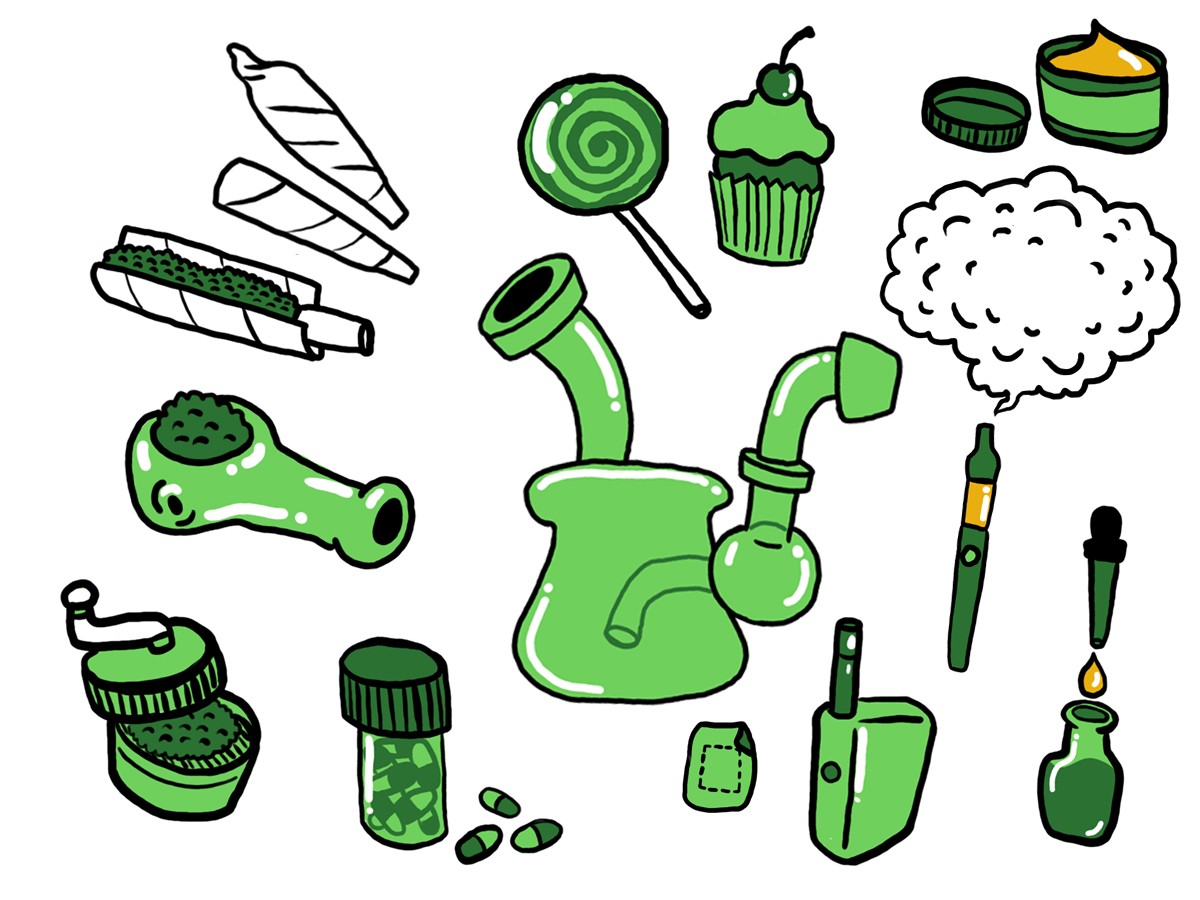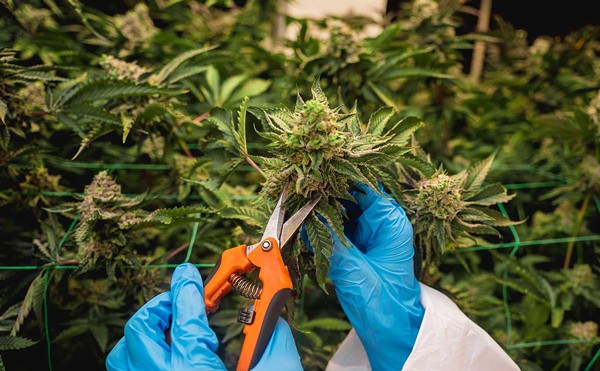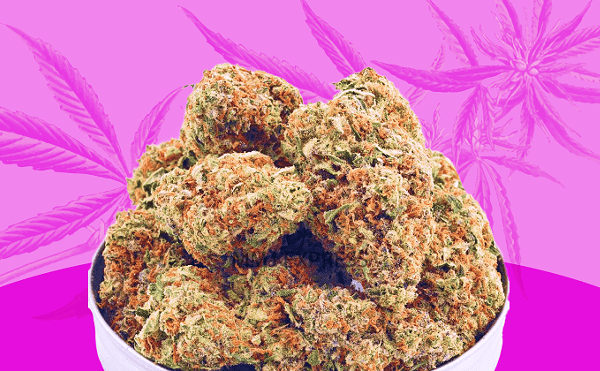When asked in 1992, Bill Clinton, then Democratic frontrunner for president of the United States, said he had, in fact, tried marijuana once in college, but never inhaled. Right. A saxophone-playing politician never inhaled marijuana. OK.
So, what does this mean in 2019? Well, for one, the stigma surrounding marijuana use is not nearly as intense as it was when Slick Willie was vying for the presidency. It also means that since Michigan flipped the script on reefer madness by legalizing the recreational use of marijuana, there's a lot to learn for the novice — and way more options than pinners of sock-drawer Reggie. By now, Aunt Becky has probably heard the ladies of The View chittering about CBD oil for arthritic pets, and your boss may have shown up to work late after suffering a gnarly third-degree burn from a recent amateur dabbing accident. (Ouch!) The long and short of it? Everyone's doing it.
And now you can, too. Welcome to Metro Times' beginners guide to smoking, vaping, eating, tripping, and, yes, dabbing.
Flower
Other names: Broccoli, chronic, dutchie, ganja, grass, mary jane, reefer, pot, the devil's lettuce, jazz cabbage, uptown skunk, tree
What is it: Once a cannabis plant goes through the stages of flowering, it is then harvested, dried, and cured, thus making it ready to smoke. This is your granddad's weed. (Though in 2019, has been upgraded significantly, thanks to years of selective breeding.)
How to take it: Once stems and seeds have been removed, grind it up and pack it in a number of different devices to smoke, each one providing a similar effect. Though grinding isn't necessary, the oil on your fingertips can strip the viable THC crystals (the stuff that gets you high) from the bud, thus reducing its potential potency.
Devices: Joints, cones, bowls, pipes, bongs, bubblers, one-hitters, apple bongs, soda cans
What it feels like: Ranges from euphoria to paranoia, depending on the strain specifics and class. Indica strains: sleep, sedation, relaxation. Sativa strains: energizing, cerebral, and social. Hybrid: depending on the strain's parent plant, hybrid strains tend to be the best of both worlds.
Duration of high: 1-3 hours, depending on strain makeup, personal metabolism, and tolerance.
How to dose: Flower is perhaps the most straightforward method when it comes to dosing, as the effects are instant. Usually dosed in terms of grams: ¼ gram=lightweight, ½=casual smoker, 1 gram=pro pothead.
Suggested experience level: Novice+
Tips: Always pass to your left, be ready to cough a lot.
Cost: $
Concentrates
Other names: Vaping
What is it: Concentrates are created once trichomes (the plant glands that contain the good stuff: cannabinoids THC and CBD) are extracted from the plant material and accumulated. When cut with high-viscosity agents like a vegetable glycerine, the product becomes a vaporizer-ready concentrate.
How to take it: Pre-filled concentrate cartridges make it easy for anyone to consume. Many just fit into your preferred vaping device, or pen. There is nothing to "burn," as vaping does not require a fire element, meaning it is non-carcinogenic, and activated via an internal controlled heat.
Devices: There are two main devices: portable, rechargeable vape pens and stationary desktop vaporizers. Vape pens often use pre-filled, strain-specific concentrate cartridges that screw into the heating element, or "pen" portion. Slightly larger and more powerful portable vapes, like the PAX, can convert flower, oil, or concentrate into vapor. Desktop versions (Volcano, HotBox) usually vaporize dried flower and allow users to control temperature. Both devices are offered in push-button or inhale sensory variations.
What it feels like: Some describe it as being "cleaner" than smoking, and others claim that vaping allows for a more robust flavor profile of the strain, as it is not masked by burning.
Duration of high: 1-3 hours
How to dose: Low and slow, and a little goes a long way. Vape devices do not hit like a joint, but, like smoking, vaping effects are instant.
Suggested experience level: Novice+
Tips: Unlike smoking flower — which gives you the instant fire-in-the-lungs sensation, which might otherwise stop you from going too hard — vaping is smoother, which means it's easy to hit too hard if you're not careful. Vaping is often praised for being odorless. Warning: it's not. The smell of burnt popcorn will give you away at the office.
Edibles
Other names: Medibles, space cakes, magic brownies
What is it: Most edibles are made with cannabis-infused oil or butter (canna-butter), which occurs after decarboxylating the marijuana. That's science talk for heating the weed in such a way as to activate the plant's psychoactive element. In other words, you can't just dump dry herb into brownie mix and expect to get baked. Once consumed, the body's liver metabolizes the cannabis' delta-9 THC and converts it to 11-hydroxy-THC — in other words, the really fucking potent stuff. To be truly effective, though, cannabis needs to bond to fat like butter, olive oil, coconut oil, or hell, even bacon fat. Like fat, cannabis is hydrophobic (repels water) and because your body has fatty tissue for those trippy molecules to hang out in, this is a happy, fatty relationship.
How to take it: If you can eat it, you can likely put weed in it and eat it:
Devices: Primarily baked goods, sweets, and candies.
What it feels like: Edibles are notorious for supplying a full-body high — brain to toes. Because it takes longer to take effect (30 minutes to 3 hours) and lasts longer than any other method (4 to 6 hours), it's crucial to listen to your body. A sign that you've taken too much? Dry mouth, rapid heart rate, and paranoia. A sign that you may have transcended into a state of ultimate highness? Couch lock, euphoria, body buzz, and a general pleasant feeling of "floatiness."
Duration of high: 4-6 hours.
How to dose: Err on the side of caution. Again, low and slow is applicable here, but dosing is still the trickiest part as there are several factors ranging from individual metabolism, what you've consumed already that day, environment, and the type of edible. For example, a full stomach might delay the effects of an edible, and an empty stomach might make you trip balls and feel sick. If you smoke a .5 gram joint comfortably by yourself, a 10 mg THC edible would be comparable in terms of tolerance. For those with little to no tolerance or are wary of this method, it is suggested to start with 2 mg for your first three edible experiences before ramping up to 5 mg and then level out at 5 mg for your next few trips before hitting the 10 mg, and so on. Ate a cookie and don't feel anything? Wait at least two hours before grabbing another. If purchasing from a provisioning center, all edibles will be labeled with THC and CBD content to best inform your experience.
Suggested experience level: Intermediate+
Tips: You can always eat more, but you can never eat less. While it is easy to take too much, you will be OK, though it might be very uncomfortable for a while. Keep a best bud on hand to talk you through your new altered state of consciousness. Or just queue up some episodes of The Joy of Painting with Bob Ross and find your nearest domestic feline to stroke. Enjoy the ride. You're going to be just fine.
Cost: $
Transdermal
Other names: Patches
What is it: Think of it like a medicated Band-Aid. Considerably the most discreet method, patches come in isolated cannabinoid varieties depending on your needs. Consumers looking to reduce inflammation might benefit from a CBD patch, while patches with CBN (or cannabinol, another compound found in cannabis) might serve those looking to get some deep sleep.
How to take it: Peel and stick onto clean, bare skin, preferably to a venous part of the body (like an ankle or wrist). Body heat will activate the cannabinoids infused within the patch, which releases the THC into your bloodstream. Neat!
Devices: Adhesive patch
What it feels like: Not a high, per se, as the patch works as a slow-timed release so there are no psychoactive effects. Patches are commonly used for full-body relief rather than spot treatment as offered by various topical ointments and lotions.
Duration of high: Patches are known to alleviate pain, anxiety, and insomnia for upwards of 8 hours.
How to dose: Dosing patch usage is very accurate, so it's best to follow the package instructions. Unlike other methods, you can simply remove the patch if you experience undesirable effects.
Suggested experience level: Novice+
Tips: Be sure to remove the patch after its suggested duration as to avoid skin irritation.
Cost: $
Wax, shatter, oil, hash, distillates
Other names: Dabbing, the crack of cannabis, rosin, hash, crumble, THCA Crystalline, sauce, and Moon Rocks.
What is it: Oil, wax, and shatter are all concentrates or extractions. To get all Bill Nye on you, hydrocarbon extraction strips the THCA gland heads from the plant material, resulting in a number of different kinds of concentrate depending on input, temperature, and solvent. Hash, rosin and other concentrates can be made from the same plant material using water and dry ice to make non-solvent concentrates. Both wax and shatter are butane hash oil concentrates and provide a similar high, the only major difference is appearance (wax looks like honey, and shatter looks like shards of glass). Because of their potency, they tend to be the higher price point, often starting at $40 per gram.
How to take it: While concentrates can be smoked and ingested orally, dabbing is one of the most popular ways to consume this form of cannabis, as it is the easiest way to reach the cannabinoid ceiling by using very little product (hence the term "dab"). Ultimately, dabbing is just flash vaporization: Heat is applied to a hot surface, usually by using a blowtorch, before the concentrate is applied to the surface and inhaled. Many people use a dab rig to consume concentrates, which, in most cases, is similar to a water pipe but with a few extra pieces, including a nail (or the surface that gets heated), the dabber (or the piece that you use to place the tiny little crumb of concentrate onto the hot surface), and a carb cap, which is similar to a traditional water pipe slider but is used to cover the "dab" once you've begun inhaling.
Devices: Dab rig, E-Nail, Nectar Collector, joint/blunt, spoon. Dab rigs range in price and quality and newer devices are being made available that do not require a torch. Remember you can always just wrap wax around a joint and smoke it, though it defeats the benefits, flavors, and ritual of dabbing by eliminating the flash vaporization process.
What it feels like: Extremely cerebral and potentially dizzying. Unlike flower, you do not have to draw very hard as this can impact what dabbing feels like. While it is super heady, it is also a heavy high and can make your limbs feel weighted, which can result in major pain relief for some dabbers.
Duration of high: 2-4 hours
How to dose: When it comes to dabbing, a little goes a long way, as concentrates are very potent and can test as high as 50-80 percent THC, depending on strain and quality — in other words, one hit could feel like 10 joints. Beginners should try 1/10th of a gram which looks like the size of a little baby crumb. The feeling is instantaneous so it will be made very clear as to whether that dose is too much.
Suggested experience level: Varsity (beginners should enlist supervision or a dab-master to administer first attempts; this shit is complicated).
Tips: Sit while dabbing, as it goes straight to the head, and never dab with alcohol-based extracts.
Cost: $$$
Tinctures
Nicknames: Happy drops
What is it: Perhaps one of the oldest forms of cannabis consumption, tinctures are one of the most effective, discreet, and controllable methods. While a tincture may technically be edible, the process and its effects are different. A tincture, by definition, is "a medicine made by dissolving a drug in alcohol" and in the case of cannabis tinctures, the dissolving of plant material. Now, "breaking down" by no means suggests a "lessened" effect. Quite the contrary. The breakdown means all the good stuff is in the driver's seat of a tincture. It is also considered one of the most ideal methods for those with gastrointestinal issues, or who may be too ill of health to smoke or vaporize.
How to take it: Tinctures come in a glass bottle, which allows for easy consumption. The key is to place drops under the tongue (sublingual) and allow it to dissolve for 30 seconds as tinctures are meant to be absorbed, not swallowed. Also, that gnarly artery under your tongue is one of the fastest paths to absorption to the brain.
Devices: Eyedropper
What it feels like: Like other methods, a tincture is available in CBD or THC varieties, depending on what the user is treating. With CBD-dominatant tinctures, expect body relaxations, lessened anxiety (if you had any to begin with), and ready for rest. For THC-heavy tinctures, the high is similar to an edible, but with more control and shorter duration and may offer some pain relief.
Duration of high: The tincture high can be felt soon after dosing, but is often slower than if one were to smoke and faster than an edible, even if the strain across all three is the same. Similarly, the effects from tincture will keep you high for longer than when you smoke or vape, but won't lock you into a six-hour high like with edibles. Two to three drops under the tongue might take 15-25 minutes to notice. If you happen to swallow it, it might take closer to 2-3 hours to notice its effects.
How to dose: Two to three drops is an ideal starting point for those with some experience with marijuana or tinctures. After an hour and a half, the full body-mind sensations should have made themselves present as to better gauge if you need to dose more or less.
Suggested experience level: Novice+
Tips: CBD tinctures are rising in popularity. But CBD has been known to make it harder for your liver to process other medication, especially medication used to treat heart conditions.
Cost: $$
Capsules
Other names: Chill pills
What is it: There are three kinds of cannabis capsules or pills that might come up when conducting Google research. One is an expensive FDA-approved and potent marijuana-like synthetic drug called Marinol, which was developed to treat post-surgical pain, as well as nausea and anorexia resulting from chemotherapy or AIDS. The other is THC capsules, which are available through marijuana provisioning centers, contain actual CO-2 extraction from the entire cannabis plant, and, for that reason, often yield high levels of THC (after being mixed with a fat or glycerine because, remember, THC is not water-soluble). Ailment- or effect-specific CBD tablets, if extracted from hemp rather than cannabis, can be purchased online. Because Marinol is not technically marijuana, as it lacks the complex cannabinoid and terpene compounds found in the plant, we'll focus on capsules you'll encounter while weed shopping — great options for those looking for a discreet method with explicit dosing. They're also ideal for diabetics, as they don't contain the sugar that often is associated with other edibles.
How to take it: No magic here, nor does one need any tools to consume. If you can take a vitamin, taking a THC tablet will be a breeze.
What it feels like: There are capsule varieties that offer THC and CBD, which might be ideal for anyone looking to reap all the benefits of the plant (pain relief and a trip) without the intense "my face is melting/are the cops here?" anxiety. Remember: THC and CBD are very good friends.
Devices: Precisely dosed capsules.
Duration of high: On average, THC capsules may take 45-120 minutes to kick in, sometimes longer because your body is busy converting THC into 11-Hydroxy-THC, which tends to be more intense than if one were to smoke.
How to dose: Swallow with a glass of water
Suggested experience level: Intermediate+
Tips: Because of the high concentration of THC, the rules for edibles apply here.
Cost: $$$
Topical
Other names: Cream
What is it: Our bodies are armed with cannabinoid receptors (yes, we were born to get high), which means you can even ingest cannabis through your skin. Many topicals are combined and paired with essential oils such as lavender, peppermint, menthol, or lemon for additional healing effects.
How to take it: Unlike transdermal patches that breach the bloodstream, topicals penetrate deep tissues and interact with the skin's CB1 and CB2 receptors, which control inflammation response.
Devices: Balms, salves, lotions, creams, bath salts and bath bombs, liniments, lubricants, massage oils
What it feels like: Because topicals are non-psychoactive, there is no "high," as they are used to treat localized pain and inflammation ranging from arthritis to menstrual cramps and migraines. When combined with other ingredients, a tingling, warming, or cooling effect could also be present, which provide their own benefits. In addition to pain, topicals have also been effective in treating skin conditions such as psoriasis and eczema. There is also an exploratory market of cannabis-infused sexual lubricants and massage oils, as cannabis has been known to heighten pleasure during intercourse, especially for women.
Duration of high: Most topicals, once applied, provide instant results and can last several hours.
How to dose: While you may be tempted to bathe in the stuff, it's not necessary. But you can apply as generously or as little as needed and as often throughout the day.
Suggested experience level: Novice+
Tips: Wash your hands after applying to avoid getting it in your eyes.
Cost: $$
Other helpful terms for the budding stoner
Blunt: A joint rolled with cigar/cigarette paper.
Bong: A water pipe.
Dankrupt: When you’re out of weed.
Grinder: A device used to evenly grind dry weed.
Kief: A dry sift mixture of trichomes, stalks, and plant matter. Often accumulates at the bottom of a grinder and is a great addition to any bowl or joint.
One-hitter: An end-to-end “pipe” that allows for efficiency and, often, just one hit. Also called a chillum.
Pinner: A long and skinny joint, usually a result of using a rolling machine.
Pre-roll: A joint that’s already been rolled and is ready to smoke.
Roach: The tail end of a joint, spliff, or blunt.
Spliff: Nicotine mixed with marijuana.
Twaxing: When one wraps a coil of concentrated wax around a joint or blunt.
From our beginners guide to marijuana issue.
It's a new era for marijuana in Michigan. Sign up for our weekly weed newsletter, delivered every Tuesday at 4:20 p.m.






